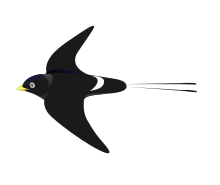| White-eyed river martin | |
|---|---|

| |
| Scientific classification | |
| Domain: | Eukaryota |
| Kingdom: | Animalia |
| Phylum: | Chordata |
| Class: | Aves |
| Order: | Passeriformes |
| Family: | Hirundinidae |
| Genus: | Pseudochelidon |
| Species: | P. sirintarae
|
| Binomial name | |
| Pseudochelidon sirintarae | |

| |
| Spot shows former wintering location within Thailand; the breeding range is unknown. | |
| Synonyms[5] | |
| |
The white-eyed river martin (Pseudochelidon sirintarae) is a passerine bird, one of only two members of the river martin subfamily of the swallows. Since it has significant differences from its closest relative, the African river martin, it is sometimes placed in its own genus, Eurochelidon.[1] First found in 1968, it is known only from a single wintering site in Thailand, and may be extinct, since it has not been seen since 1980 despite targeted surveys in Thailand and neighbouring Cambodia. It may possibly still breed in China or Southeast Asia, but a Chinese painting initially thought to depict this species was later reassessed as showing pratincoles.
The adult white-eyed river martin is a medium-sized swallow, with mainly glossy greenish-black plumage, a white rump, and a tail which has two elongated slender central tail feathers, each widening to a racket-shape at the tip. It has a white eye ring and a broad, bright greenish-yellow bill. The sexes are similar in appearance, but the juvenile lacks the tail ornaments and is generally browner than the adult. Little is known of the behaviour or breeding habitat of this martin, although like other swallows it feeds on insects caught in flight, and its wide bill suggests that it may take relatively large species. It roosts in reed beds in winter, and may nest in river sandbanks, probably in April or May before the summer rains. It may have been overlooked prior to its discovery because it tended to feed at dawn or dusk rather than during the day.
The martin's apparent demise may have been hastened by trapping, loss of habitat and the construction of dams. The winter swallow roosts at the only known location of this martin have greatly reduced in numbers, and birds breeding at river habitats have declined throughout the region. The white-eyed river martin is one of only two birds endemic to Thailand, and the country's government has noted this through the issues of a stamp and a high-value commemorative coin.
- ^ a b BirdLife International (2021). "Eurochelidon sirintarae". IUCN Red List of Threatened Species. 2021: e.T22712042A203170332. doi:10.2305/IUCN.UK.2021-3.RLTS.T22712042A203170332.en. Retrieved 26 May 2023.
- ^ "Appendices | CITES". cites.org. Retrieved 2022-01-14.
- ^ Dickinson, E C; Dekker, R W R J; Eck, S & Somadikarta, S (2001). "Systematic notes on Asian birds. 14. Types of the Hirundinidae". Zoologische Verhandelingen, Leiden. 335: 145–166. Archived from the original on 2014-04-24. Retrieved 2012-10-26.
- ^ Cite error: The named reference
Turnerwas invoked but never defined (see the help page). - ^ "Pseudochelidon sirintarae". Avibase.
